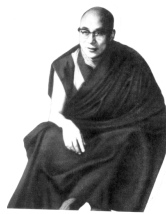
AMITA BUDDHA, KWAN-SHAI-YIN, AND KWAN-YIN —
WHAT THE “BOOK OF DZYAN” AND THE
LAMASERIES OF TSONG-KHA-PA SAY
As a supplement to the Commentaries there are many secret folios on the lives of the Buddhas and Bodhisattvas, and among these there is one on Prince Gautama and another on His reincarnation in Tsong-Kha-pa. This great Tibetan Reformer of the fourteenth century, said to be a direct incarnation of Amita-Buddha, is the founder of the secret School near Shigatse, attached to the private retreat of the Teshu-Lama. It is with Him that began the regular system of Lamaic incarnations of Buddhas (Sang-gyas), or of Sâkya-Thub-pa (Sâkyamuni). Amida or Amita-Buddha is called by the author of Chinese Buddhism, a mythical being. He speaks of
Amida-Buddha (Ami-to Fo) a fabulous personage, worshipped assiduously—like Kwan-yin—by the Northern Buddhists, but unknown in Siam, Burma, and Ceylon.*
Very likely. Yet Amida-Buddha is not a “fabulous” personage, since (a) “Amida” is the Senzar form of “Âdi”; “Âdi-Buddhi” and “Âdi-Buddha,”† as already shown, existed ages ago as a Sanskrit term for “Primeval Soul” and “Wisdom”; and (b) the name was applied to Gautama Sâkyamuni, the last Buddha in India, from the seventh century, when Buddhism was introduced into Tibet. “Amitâbha” (in Chinese, “Wu-liang-sheu”) means literally “Boundless Age,” a synonym of “Ain-Soph,” the “Ancient of Days,”and is an epithet that connects Him directly with the Boundless Âdi-Buddhi (primeval and Universal Soul) of the Hindus, as well as with the Anima Mundi of all the ancient nations of Europe and the Boundless and Infinite of the Kabalists. If Amitâbha be a fiction of the Tibetans, or a new form of Wu-liang-sheu, “a fabulous personage,” as the author-compiler of Chinese Buddhism tells his
—————
* Chinese Buddhism, p. 171, by Rev. J. Edkins.
† “Buddhi” is a Sanskrit term for “discrimination” or intellect (the sixth principle), and “Buddha” is “wise,” “wisdom,” and also the planet Mercury. [ Budha].
—————

HIS HOLINESS, THE XIVth DALAI LAMA
Born July 6, 1935
Page 426
readers, then the “fable” must be a very ancient one. For on another page he says himself that the addition to the canon, of the books containing the
. . . legends of Kwan-yin and of the Western heaven with its Buddha, Amitâbha, was also previous to the Council of Cashmere, a little before the beginning of our era.*
and he places
the origin of the primitive Buddhist books which are common to the Northern and Southern Buddhists . . . . before 246 B.C.
Since Tibetans accepted Buddhism only in the seventh century A.D., how comes it that they are charged with inventing Amita-Buddha? Besides which, in Tibet, Amitâbha is called Od-pag-med, which shows that it is not the name but the abstract idea that was first accepted of an unknown, invisible, and Impersonal Power—taken, moreover, from the Hindu “Âdi-Buddhi,” and not from the Chinese “Amitâbha.”† There is a great difference between the popular Od—pag-med (Amitâbha) who sits enthroned in Devachan (Sukhâvatî), according to the Mani Kah-’bum Scriptures—the oldest historical work in Tibet, and the philosophical abstraction called Amita-Buddha, the name being passed now to the earthly Buddha, Gautama.
—————
* This curious contradiction may be found in Chinese Buddhism, pp. 171, 273-74. The reverend author assures his readers that “to the philosophic Buddhists . . . Amitâbha Yoshi Fo, and the others are nothing but signs of ideas” (p. 236). Very true. But so should be all other deific names, such as Jehovah, Allah, etc., and if they are not simply “signs of ideas” this would only show that minds that receive them otherwise are not “philosophic”; it would not at all afford serious proof that there are personal, living Gods of these names in reality.
† The Chinese Amitâbha (Wu-liang-sheu) and the Tibetan Amitâbha (Od-pag-med) have now become personal Gods, ruling over and living in the celestial region of Sukhâvatî, or Tushita (Tibetan: Devachan); while Âdi-Buddhi, of the philosophic Hindu, and Amita-Buddha of the philosophic Chinese and Tibetan, are names for universal, primeval ideas.
—————